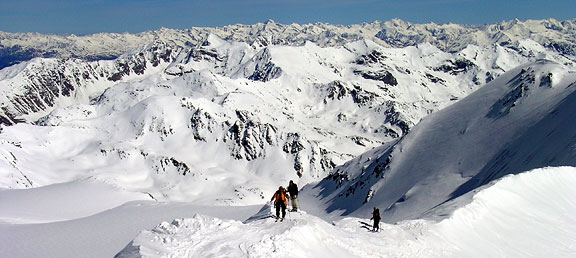 |
|
| Ötztaler Ski Touring & Ascents |
| 7 days skiing Maximum
Group Size See also: | The Ötztaleralpen is a group of high peaks located about 60 kilometers southwest of Innsbruck, Austria. This heavily glaciated massif forms a curving arc along the border of Italy and Austria and is perhaps most well known as the final resting place of "Ötzi" the "Ice Man", a 5000 year old victim of foul play entombed in the glacier above the town of Vent. There are many high summits, and though they never attain the height of 4000 meters, many exceed 3500. The Wildspitze is the highest in the area at 3768 meters above sea level, and our last skiing and climbing objective! Our tour follows the natural crest of the arc of the massif following a clockwise horseshoe-shaped route high above the Ventertal and the town of Vent. We start in the ski town of Obergurgl just a short way above the larger ski resort of Sölden. From here we continue for 7 days, finally descending back into the Ötztal valley at Vent. Bill O'Conner, who authored the two volume guidebook set "Alpine Ski Mountaineering" and who's description we largely follow on our tour, says "In my opinion, it is one of the best ski tours of its standard in the Alps.", "....and can rightly be considered a classic." There are many minor variations on this tour which can be used to adjust the difficulty and ambitiousness. We can divide the group as necessary to cater to the whims and energy levels of its members. Some of us may chose to climb on foot or ski some of the more demanding summits, while others can skip many summits in favor of a more relaxed tour. There are a few moderately strenuous days, however, such as the second day when crossing the Schalfkogeljoch, and good fitness is important.
|
|
The huts for the Ötztaleralpen are first rate, many of them have showers (a sure sign of an emphasis on comfort!) and they have been likened to mini-hotels. Those of you who have enjoyed the fine huts of the Ortler group, just to the south in Italy know the pleasure of great huts. For a full ski vacation, you could also stay for a few days in the Ötztaler and enjoy good lift served skiing in either the Sölden or Obergurgl ski areas, or even make a trip to nearby St. Anton. |



